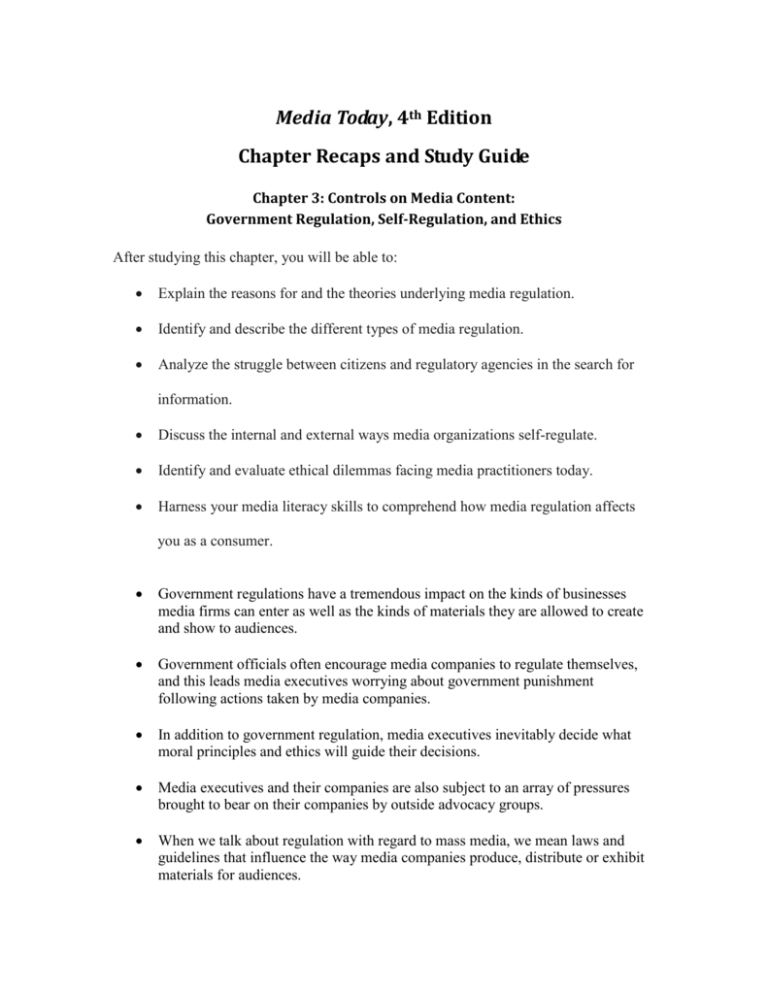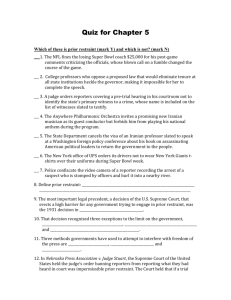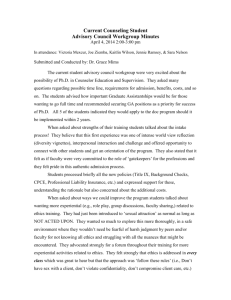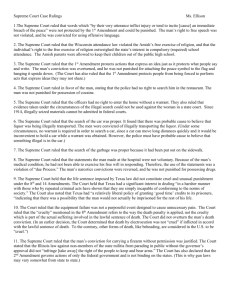Chapter 3 - Routledge
advertisement

Media Today, 4th Edition Chapter Recaps and Study Guide Chapter 3: Controls on Media Content: Government Regulation, Self-Regulation, and Ethics After studying this chapter, you will be able to: Explain the reasons for and the theories underlying media regulation. Identify and describe the different types of media regulation. Analyze the struggle between citizens and regulatory agencies in the search for information. Discuss the internal and external ways media organizations self-regulate. Identify and evaluate ethical dilemmas facing media practitioners today. Harness your media literacy skills to comprehend how media regulation affects you as a consumer. Government regulations have a tremendous impact on the kinds of businesses media firms can enter as well as the kinds of materials they are allowed to create and show to audiences. Government officials often encourage media companies to regulate themselves, and this leads media executives worrying about government punishment following actions taken by media companies. In addition to government regulation, media executives inevitably decide what moral principles and ethics will guide their decisions. Media executives and their companies are also subject to an array of pressures brought to bear on their companies by outside advocacy groups. When we talk about regulation with regard to mass media, we mean laws and guidelines that influence the way media companies produce, distribute or exhibit materials for audiences. We define regulation of mass media as the laws and guidelines that influence the way media companies produce, distribute or exhibit materials for audiences. Scholars who compare media systems around the world describe four different approaches to government regulation—authoritarian, communist, libertarian, and social responsibility. (Figure 3.1) o Authoritarian approaches to media regulation are typically adopted by dictators who want to keep themselves and the elite backing them in direct control over all aspects of their society. o Communist approaches depart from authoritarian ones, however, in the way they justify this control. o On the other end of the spectrum from authoritarian and communist approaches to media control are libertarian approaches, which are grounded in a belief in the marketplace of ideas. o Social responsibility approaches to government regulation believe that the real competition over ideas that libertarians prefer will never happen without government laws to encourage companies to be socially responsible with respect to encouraging a diversity of voices and ideas. Political influences, economic influences and/or cultural influences may help explain the differences between the ways countries translate the same approach into actual regulation. In the United States, the legal foundation for government’s relationship to the press (and, by extension, what we call the mass media) is the First Amendment to the Constitution. o In Gitlow v. New York (1925), the U.S. Supreme Court ruled that the phrase “Congress shall make no law,” as it is written in the First Amendment, should be interpreted as “government and its agencies shall make no law,” regardless of locale or level of government. o In recent decades, court decisions and political interpretations of what precisely the First Amendment means by “the press” have expanded to include all types of mass media, not just the journalistic press. In Burstyn v. Wilson (1952), the U.S. Supreme Court ruled that films were protected by the First Amendment. In CBS v. Democratic National Committee, the U.S. Supreme Court ruled that television and radio were protected by the First Amendment. In Time Inc. v. Hill (1967), the U.S. Supreme Court ruled entertainment content of media were protected by the First Amendment. In Virginia State Board of Pharmacy et al. v. Virginia Citizens Consumer Council, the U.S. Supreme Court ruled advertising and other forms of commercial speech were protected by the First Amendment. The Supreme Court has often approved government restrictions to abridge speech of the press that place limits on the time, place, and manner of expression. Such restrictions are legal if they: o Are applicable to everyone. o Are without political bias. o Serve a significant governmental interest. o Leave ample alternative ways for the communication to take place. The level of protection that the U.S. government provides depends upon the type of speech (Figure 3.3) Certain kinds of media regulation are constitutional, and these regulations can be divided into three categories: o Regulation of content before it is distributed Obscenity: Material can be judged obscene, and therefore be subject to prior restraint, based on a three-part test: An average person, applying current standards of the community, would have to find that the work as an entirety reflects an obsessive interest in sex. The work has to portray in a clearly offensive manner—in pictures or in writing—certain conduct specifically described as unallowable by state law. A reasonable person has to agree that the work lacks serious literary, artistic, scientific, or political usefulness. The U.S. Supreme Court has consistently ruled that the government has a right to censorship via prior restraint when the national security of the United States is at stake, but the Court has made it clear that national security is defined quite narrowly. The regulation and control of media content prior to publication during wartime military operations has taken place since the Civil War. The military has developed strategies to control and shape wartime reporting, using pool reporting and embedded reporting and discouraging so-called unilaterals. The Supreme Court has held that speech can be limited before it is distributed if the result of that speech is likely to pose a threat to society. Courts first used the bad tendency test to evaluate potential harm, but inherent problems with the test eventually gave way to Justice Oliver Wendell Holmes’ clear and present danger test. According to the U.S. Constitution, the purpose of copyright is “to promote the progress of science and the useful arts.” The hesitancy of government agencies to stop the press from circulating content through prior restraint does not apply to copyright violations. The Copyright Act of 1976 lays out the basic rules of copyright law as it exists in the U.S. today. Fair use regulations allow writers and academics to use small portions of copyrighted material without permission. Fair use is typically supportive of nonprofit, educational uses of copyrighted material, and of uses that do no harm to the original work or that significantly transform the original work with added interpretations, including parodies of the original work. The Supreme Court has allowed prior restraint of primary and secondary school newspapers if the publication of such a newspaper is part of the school’s curriculum. The right to free speech, as protected under the First Amendment, often comes into conflict when it comes up against the right to a fair trial, as protected under the Sixth Amendment, and is another area in which prior restraint is often allowed, through gag orders. Commercial speech may be subject to prior restraint if it appears to be false or misleading. o Regulation of content after it is distributed. Defamation is a highly disreputable or false statement about a living person or an organization that causes injury to the reputation that a substantial group of people hold for that person or entity. Libel is a form of published defamation, including libel per se (so-called “red flag” words) and libel per quod (words that become libelous because of their context) Slander is a form of spoken defamation. There are two categories of libel plaintiffs: public figures and private persons. The U.S. Supreme Court has defined actual malice as reckless disregard for truth or knowledge of falsity; the Court has defined simple malice as ill will toward another person. The Court has defined simple negligence as lack of reasonable care by media organizations. A plaintiff in a libel suit must prove these five elements apply to the case in order to prove libel: o The defamatory statements were published. o The defamatory statements identified the plaintiff (although not necessarily by name). o The defamatory statements harmed the plaintiff. The FCC and content regulation. The Court has accepted the idea that the FCC can limit broadcast content in a limited way. o The FCC has determined that broadcast TV stations must provide three hours a week of educational programming aimed at children. o The FCC has determined that broadcasters must provide equal amounts of time during comparable parts of the day to all legally qualified candidates for public office. o The FCC has set aside the so-called Fairness Doctrine that required broadcasters to provide balance in the presentation of controversial issues. o The power of the FCC rests in its ability to fine stations and, under some circumstances, to revoke station licenses. o The defendant was at fault. o The defamatory statements were false. Defenses in libel suits include: o Truth o Privilege o Fair comment and criticism. Privacy—the right to be protected from unwanted intrusions or disclosures—is a broad area of the law when it comes to media industries, and includes false light, appropriation, public disclosure, and intrusion. o In our current digital age, privacy is being invaded in new and different ways. In the United States, laws like the Cable Telecommunications Act of 1984 and the Children’s Online Privacy Protection Act aim to protect people from media firms and other companies that illegally obtain information and invade the privacy of private citizens. Economic regulations placed on media organizations greatly affect the ways in which those organizations finance, produce, exhibit, and distribute their products. o One way that regulators who want to expand the marketplace for ideas can do so without directly making rules about content is by limiting excessive market control by mass media corporations. o Excessive market control can lead to situations of oligopoly or even monopoly. o Anti-trust policies aim to ensure competition in the U.S. economy, through enforcement of laws by the U.S. Justice Department. The Federal Trade Commission (FTC) and the Federal Communications Commission (FCC) are the two most important Federal agencies involved in regulating the mass media. Although opportunities for prior restraint on publication by governments are rather limited under the U.S. Constitution, government officials have tried other ways to prevent journalists from gaining access to certain types of information. o One way that the government can limit speech—especially speech about the workings of the government—is to restrict access to government documents and meetings. o Journalists often claim evidentiary privilege in order to protect confidential sources, but the privilege is not always granted by the courts. o On the federal level a major victory for openness came in the form of the Freedom of Information Act (FOIA), which allows citizens to request government records and reports that have not yet been made public, with these nine restrictions: National security Agency interpersonal activities Statutory exemptions Trade secrets Some intra-agency and inter-agency memos Issues involving personal privacy Police investigations Protection of government-regulated financial institutions Information about oil and gas wells. Many states have passed so-called sunshine laws, which ensure that government meetings and reports are made available to the press and members of the public. Press organizations have managed to convince legislators in 30 states and the District of Columbia to pass shield laws that afford the media varying degrees of protection against being forced to disclose information about their sources. A number of pressures, both external and internal to the media industry, are aimed at ensuring that media professionals conduct forms of self-regulation and operate an ethical manner. o External pressures to self-regulate include various stakeholders: members of the public, advocacy organizations or pressure groups, academics, and advertisers. o Internal self-regulation can take a number of forms, including editorial standards (specified in policy books, operating policies, and editorial policies) and ombudspersons at the level of individual organizations, as well as professional codes of ethics, content ratings, press councils and journalism reviews at the industry level. o Most media organizations have established editorial standards, or written statements of policy and conduct. o Professional codes of ethics are often administered by societies or associations that companies have established to represent their interests to the outside world as well as to forces within their businesses that might be acting in ways members consider unprofessional. o Another way that media organizations regulate themselves is through the adoption of ratings systems like those in the TV, film, and video game industries. o Press councils differ from ombudspersons because they are made up of more than one person, and they are not directly employed by any one media organization. o Journalism reviews are yet another external force that helps the media to self-regulate. Ethics is a system of principles about what is right that guides a person’s actions. o By applying one or more classical approaches to ethics, we can better evaluate—from an ethics standpoint, at least—our behavior and the behavior of others. o Aristotle’s Golden Mean represents the average of the extreme actions between the intellectual and moral virtues. o The Judeo-Christian ethic, also known as the Golden Rule, refers to the admonition to “do unto others as you would have them do unto you.” o Emmanuel Kant’s theory of the categorical imperative holds that the individuals should follow ethical principles as if they could be applied in any situation. o The phrase, “the greatest good for the greatest number,” is the foundation of John Stuart Mill’s principle of utility. o John Rawls’ veil of ignorance theory holds that in any given situation justice emerges only when all parties are treated without social differentiation. Bob Steele outlines the following model (10 questions that you ask yourself) that media literate persons and media professionals can use to evaluate decisions and to make good ethical decisions: o What do I know? What do I need to know? o What are my ethical concerns? o What is my journalistic (or informational, entertainment, advertising, or educational) purpose? o What organizational policies and professional guidelines should I consider? o How can I include other people, with different perspectives and diverse ideas, in the decision-making process? o Who are the stakeholders—those affected by my decision? What are their motivations? Which are legitimate? o What if the roles were reversed? How would I feel if I were in the shoes of one of the stakeholders? o What are the possible consequences of my actions in the short term? In the long run? o What are my alternatives to maximize my truth-telling responsibility and minimize harm? o Can I clearly and fully justify my thinking and my decision to my colleagues? To the stakeholders? To the public? Media ethics scholars Mark Fackler, Kim Rotzoll, and Clifford Christians have identified a list of the five main duties of media professionals—all of which can and do cause knotty ethical situations. o Duty to self o Duty to audience o Duty to the employer o Duty to promise holders o Duty to society. Ethical standards regarding the mass media often relate to at least three levels— the personal, professional and societal, and ethical actions involve values, ideals, and principles. Sometimes people who work in mass media organizations might feel strong conflicts among the various duties they have and among the various ethical standards to which they try to subscribe. Even if you’re not a media practitioner, thinking seriously about the formal and informal controls on the media content you see and hear each day is crucial to your role as a critical consumer of media.








